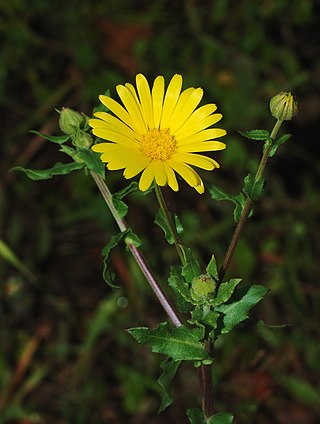
Calendula is a genus of about 15–20 species of annual and perennial herbaceous plants in the daisy family, Asteraceae that are often known as marigolds. They are native to southwestern Asia, western Europe, Macaronesia, and the Mediterranean. Other plants known as marigolds include corn marigold, desert marigold, marsh marigold, and plants of the genus Tagetes.

Polypores are a group of fungi that form large fruiting bodies with pores or tubes on the underside. They are a morphological group of basidiomycetes-like gilled mushrooms and hydnoid fungi, and not all polypores are closely related to each other. Polypores are also called bracket fungi or shelf fungi, and they characteristically produce woody, shelf- or bracket-shaped or occasionally circular fruiting bodies that are called conks.

A tincture is typically an extract of plant or animal material dissolved in ethanol. Solvent concentrations of 25–60% are common, but may run as high as 90%. In chemistry, a tincture is a solution that has ethanol as its solvent. In herbal medicine, alcoholic tinctures are made with various ethanol concentrations, which should be at least 20% alcohol for preservation purposes.
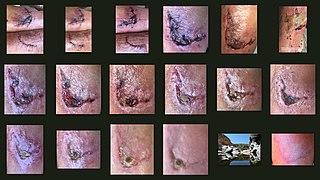
Wound healing refers to a living organism's replacement of destroyed or damaged tissue by newly produced tissue.

Lingzhi, Ganoderma sichuanense, also known as reishi or Ganoderma lingzhi is a polypore fungus native to East Asia belonging to the genus Ganoderma.
An angiogenesis inhibitor is a substance that inhibits the growth of new blood vessels (angiogenesis). Some angiogenesis inhibitors are endogenous and a normal part of the body's control and others are obtained exogenously through pharmaceutical drugs or diet.
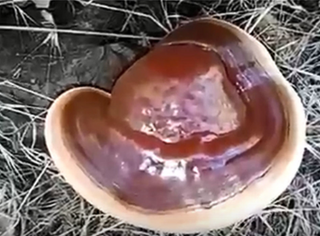
Ganoderma lucidum is a red-colored species of Ganoderma with a limited distribution in Europe and parts of China, where it grows on decaying hardwood trees. Wild populations have been found in the United States in California and Utah but were likely introduced anthropogenically and naturalized.

Ganoderma applanatum is a bracket fungus with a cosmopolitan distribution.
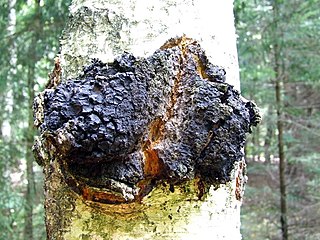
Inonotus obliquus, commonly called chaga, is a fungus in the family Hymenochaetaceae. It is parasitic on birch and other trees. The sterile conk is irregularly formed and resembles burnt charcoal. It is not the fruiting body of the fungus, but a sclerotium or mass of mycelium, mostly black because of a great amount of melanin. Some people consider chaga medicinal.

Ganoderma is a genus of polypore fungi in the family Ganodermataceae that includes about 80 species, many from tropical regions. They have a high genetic diversity and are used in traditional Asian medicines. Ganoderma can be differentiated from other polypores because they have a double-walled basidiospore. They may be called shelf mushrooms or bracket fungi.
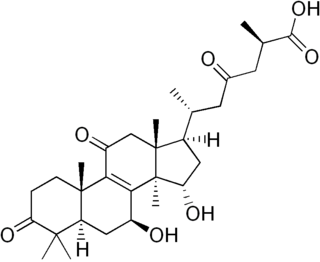
Ganoderic acids are a class of closely related triterpenoids found in Ganoderma mushrooms. For thousands of years, the fruiting bodies of Ganoderma fungi have been used in traditional medicines in East Asia. Consequently, there have been efforts to identify the chemical constituents that may be responsible for the putative pharmacological effects. The two most well described ganoderic acids out of the many that have been identified and characterized are ganoderic acids A and B. Some ganoderic acids have been found to possess biological activities including hepatoprotection, anti-tumor effects, and 5-alpha reductase inhibition.

Pleurotus pulmonarius, commonly known as the Indian oyster, Italian oyster, phoenix mushroom, or the lung oyster, is a mushroom very similar to Pleurotus ostreatus, the pearl oyster, but with a few noticeable differences. The caps of pulmonarius are much paler and smaller than ostreatus and develops more of a stem. P. pulmonarius also prefers warmer weather than ostreatus and will appear later in the summer. Otherwise, the taste and cultivation of the two species is generally described as largely the same. Another similar species, North America's Pleurotus populinus, is restricted to growing on aspen and cottonwood.

Ganoderma curtisii is a wood-decaying polypore whose distribution is primarily in the Southeastern United States. Craig and Levetin claim to have observed it in Oklahoma.
Medicinal fungi are fungi that contain metabolites or can be induced to produce metabolites through biotechnology to develop prescription drugs. Compounds successfully developed into drugs or under research include antibiotics, anti-cancer drugs, cholesterol and ergosterol synthesis inhibitors, psychotropic drugs, immunosuppressants and fungicides.
Hydrogels are three-dimensional networks consisting of chemically or physically cross-linked hydrophilic polymers. The insoluble hydrophilic structures absorb polar wound exudates and allow oxygen diffusion at the wound bed to accelerate healing. Hydrogel dressings can be designed to prevent bacterial infection, retain moisture, promote optimum adhesion to tissues, and satisfy the basic requirements of biocompatibility. Hydrogel dressings can also be designed to respond to changes in the microenvironment at the wound bed. Hydrogel dressings should promote an appropriate microenvironment for angiogenesis, recruitment of fibroblasts, and cellular proliferation.
Scytalidium ganodermophthorum is an anthroconidial ascomycete fungus in the Scytalidium genus. It is also known by its teleomorph name Xylogone ganodermophthora. It is the cause of yellow rot in lingzhi mushrooms and it is used in spalting as a pigmenting fungi.
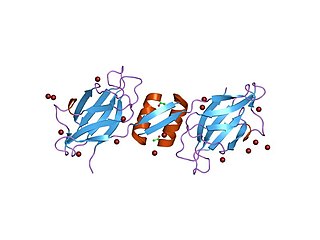
Fungal immunomodulatory proteins (FIPs) are a type of functional compound found in various species of fungi. FIPs are part of the immunoglobulin (ig) family, which are structurally similar to human antibodies, and can interact with human peripheral blood mononuclear cells (PBMCs), causing these cells to secrete different types of hormones and regulate cellular activity.
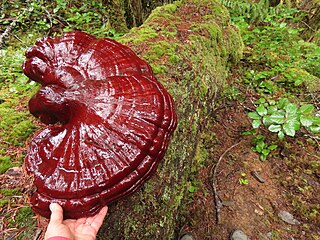
Ganoderma oregonense is a species of bracket fungus that causes root and butt white rot in conifers in northwestern coastal North America, including California, Oregon, Washington, British Columbia, Yukon, and Alaska. G. oregonense is very similar to Ganoderma tsugae, but G. tsugae is associated with east coast Tsuga (hemlock) rather than west coast conifer. Its been speculated that G. oregonense and G. tsugae might actually be one species, but mycologists just don't know for sure yet.














